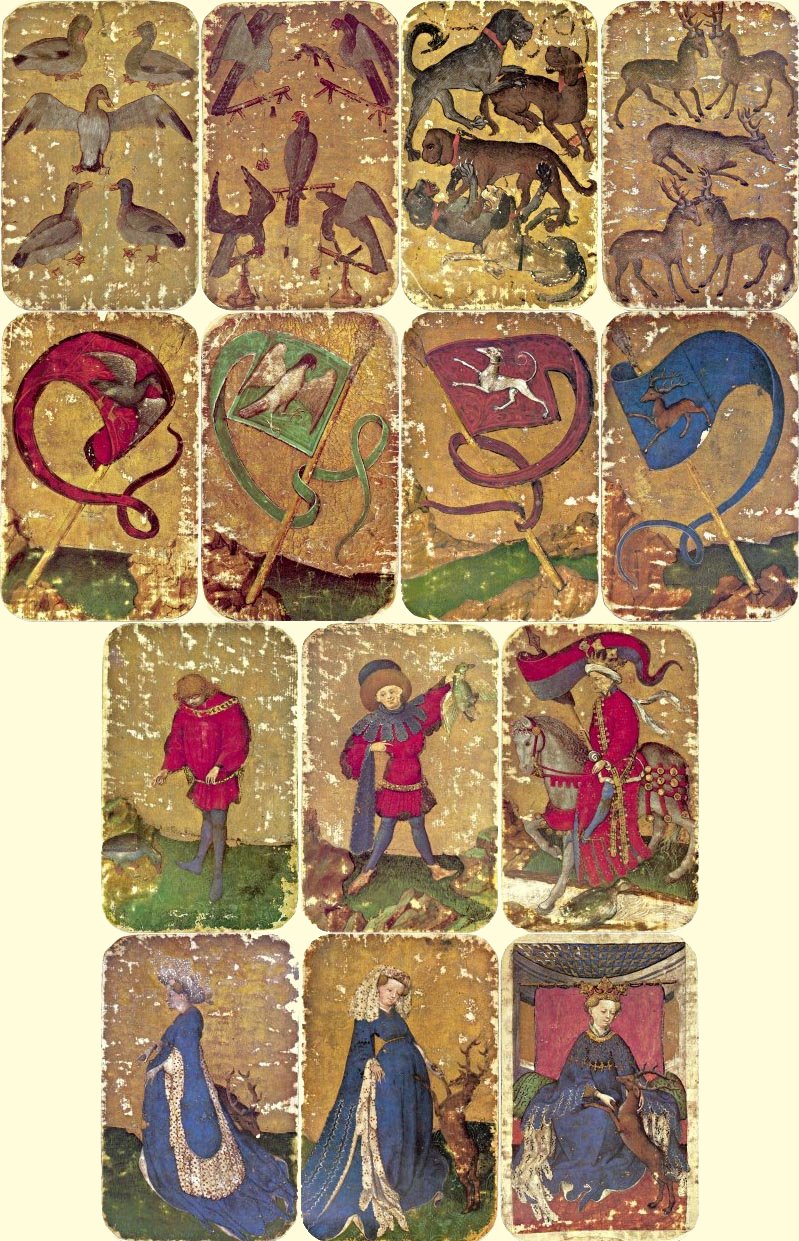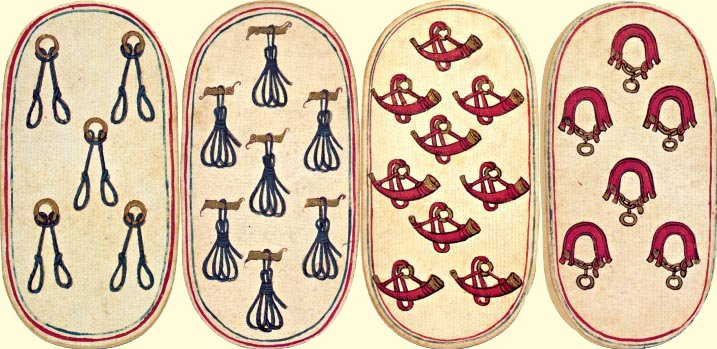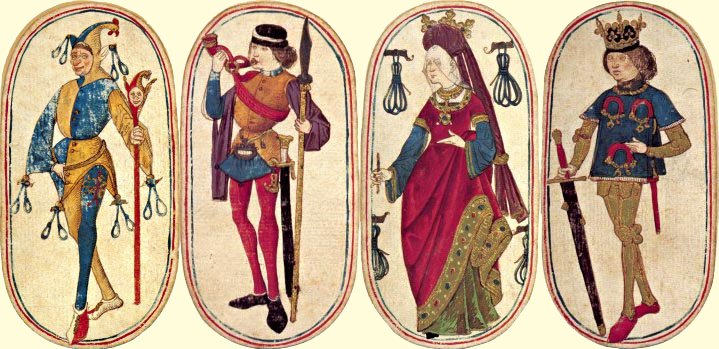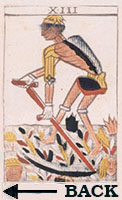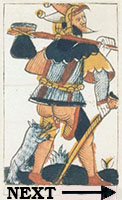THE TAROT WHEEL
THE OLDEST EUROPEAN PLAYING CARDS
Cards were introduced to Western Europe around 1375 via Venice and Spain. Very soon the cards spread all over Europe and started to change with respect to the Na'ibs or Saracen cards. We don't know what these cards looked like, but the oldest cards we have are from the 15th century. The Europeans liked the principle and adapted the decks in various ways to the games they invented:
- The number of suits varied. Most games adopted the 4 suits of the Mamluk cards, but some games had 3 or 5 suits.
- The shape of the cards varied. Most were rectangular, but some were square, had rounded edges, where oval, or even round.
- The suit symbols varied. You could see animals, flowers, hunting objects, you name it, it could become a suit symbol.
The picture below is a typical European deck that illustrates these variations. It is a German pack made in Cologne around 1500 by an unknown maker who signed his work "P.W.". There are five suits and the cards are round. The suit symbols are hares, parrots, carnations, columbines, and roses. A copy of the complete deck can be found here.
These were not the only things that changed. Some other typical features of early European card decks:
- Most games kept the 10 of numbers, but some decks dropped one or more of the pip cards, for example the one, from two to five, from two to six, etc.
- Almost all decks kept the King. Some kept the Upper and Lower Officers of the Mamluk decks. Others kept only one or two court cards. Women were introduced, a Queen replacing the Upper Officer, or slipping in between the Upper Officer and the King. In one known deck (the Visconti di Modrone) every court card got a female counterpart. In other decks some court cards were male, while in other suits they were female. The German deck from Cologne shown above had 4 court cards for each suit, making a deck of 70 cards.
- For religious reasons, Mamlûk cards could not represent living creatures and could only show figurative decorations. Catholic Europe did not have this restriction. The court cards became portraits of people, sometimes portraits of famous people who had lived or recently died. The numbered cards were often used to show scenes from nature or everyday life.
- Some other decks introduced extra cards, just a few, or sometimes many extra cards appeared, for example Roman gods or allegorical figures.
The next example is a deck from about 1455/1450, the Ambraser Hofkarten. This is another German deck, where the suit symbols are the coats of arms of a country (Germany, France, Bohemia and Hungary). The value of the cards is indicated by a Roman number. The cards show scenes from everyday life in a typical European court. Here we see card number 5 of each suit. We see a waiter, a cook, a falconer, and an archer. High resolution images of the cards can be found here.
There was a real variety in the decks. One fascinating deck is the Stuttgart Hunting Deck, dated around 1430. It is, like the two previous examples, a German deck. The card designs have some interesting features:
- The suit symbols are ducks, falcons, dogs, and stags.
- The court cards of the flying animals are all male, and the court cards of the earth-bound animals are all female.
- The 10 in the suit cards does not exist, instead we find a card with a large flag, like the Ace of Paris Tarot.
The image below illustrates these features, the full deck can be found here in high resolution.
As a final example of the diversity of early European decks, I would like to show you a Flemish deck, which like the previous deck is a hunting deck. This deck does not use animals, but hunting attributes like a hunting horn and a dog collar. The cards are not rectangular but oval and date from around 1470-80. They are kept in the Metropolitan Museum of Arts. This is probably the oldest complete set. High resolution images of this set can be found here.
The deck is what we now call standard, 10 numbered cards from one to ten and three court cards. The court cards are knaves, queens and kings. An example is shown in the picture below with two knaves, a queen and a king.
Apparently a fairly typical deck for its time was the 1420/1425 Milanese Michellino deck. This deck consisted of four suits, with Doves, Turtle-Doves, Phoenixes, and Eagles as suits, and a King as the highest court card. It had six court cards, the three male court cards that we find in other early decks were doubled by their female counterparts. But there were some extra cards, all representing Roman gods (for more details see the pages on the development of the Tarot). As you will see later, this deck is a direct ancestor of the Tarot cards.
People like to play cards with a structure and symbols they recognise. The number of 4 suits became the standard and a full deck consisted of 48, 52 or 56 cards. Over time, three families of suit symbols became more or less standard:
- Coins, Cups, Swords and Clubs in Italy and Spain (and 4 court cards instead of 3, making 56 cards), adopted for tarot decks.
- Bells, Hearts, Leaves and Acorns (or similar, no Aces, so only 48 cards) in German-speaking countries.
- Diamonds, Hearts, Spades and Clubs in France and England (52 cards), now the international standard.
The numbered cards show only the suits or, as in Sola Busca and many German decks, small drawings, often satirical.
Most of these decks were for leisure or gambling purposes only. But other card makers went further. They began to use the images on the cards to convey a message. The simplest example is the Italian suits. Some people believe that these suits, which are also used in Tarot decks, represent human society:
- The Cups represented the Holy Grail and thus the clergy, who ruled over vast territories such as the Papal States around Rome.
- The Swords represented Excalibur, the sword of Charlemagne, so the swords represented the nobility, powerful people with lots of land, like the Kingdom of Naples or the Duchy of Milan.
- The Coins were gold coins that represented the upper class of the common people, the rich merchants. These rich people ruled the free territories, such as the Republic of Venice.
- The Clubs (Batons) were made of simple wood and represented the lower class, the servants and peasants who had no land and had to work for other people to make a living.
In later pages we will explore in more detail the associations that can be made with the suits. In some decks the message became more important than the game. This is how the Tarot was born. And that is what these pages are about, the history of the Tarot and the message behind the cards.


